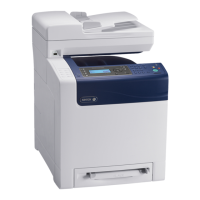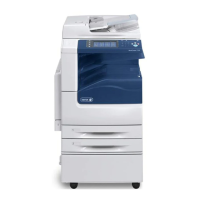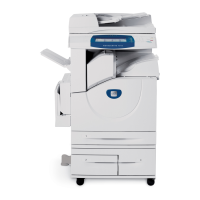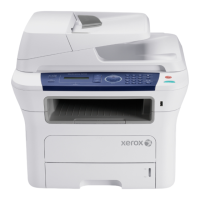December 2006
6-47
WorkCentre M20, 4118, FaxCentre 2218 Family
GP 14
General Procedures and Information
GP 14 Scanner Operation
Purpose
To give information about the operation of the scanner:
• Summary
• CCD
• Key Features
NOTE: If necessary, refer to GP 20 for the acronym list and cross reference lists of more com-
monly recognised part names.
Summary
This flat-bed type device to read manuscripts has 600dpi CCD as an image sensor. There is
one optical sensor for detecting CCD home position and scan-end position. The home position
is detected by a optical sensor which is attached to the CCD Module. The scan-end position is
calculated by the number of motor steps. Refer to Figure 1 for the scanner block diagram.
Figure 1 Block Diagram
CCD
Charge Coupled Device improves productivity and allows a compact design. The machine
uses a color CCD.
• Minimum Scan Line Time for One Color: 2.5mSec.
• Light Source Power: +18V.
• Maximum Pixel frequency: 10MHz.
• Effective Sensor Element: 5340 X 3.
• Clamp Level: 0.7 to 0.8V.
• Bright Output: MIN 0.8V8-3-2 Key Features.
Key Features
Overview
1. 0.5m C-MOS process (TLM), 208-PIN QFP, STD85 library.
2. Frequency: Max PLL 80 MHz.
3. On-Chip oscillator.
4. Method: Raster scanning method.
5. Image Sauce: 300/400/600dpi CIS & CCD.
6. Scanning Mode:
• color gray image: each 8 bits / RGB.
• mono gray image: 8 bits / pixel.
• binary image: 1 bit / pixel (for text/photo/mixed mode).
7. Maximum scanning width: A3, 600dpi (8K effective pixels).
8. Ideal MSLT (A4, 600/300dpi):
• color gray image: 3x5Kx80nsec = 1.2msec (7/28 CPM).
• mono gray image: 1x5Kx80nsec = 0.4msec (21/84 CPM).
• binary image: 1x5Kx80nsec = 0.4msec (21/84 CPM).
9. A/D conversion depth: 12bits.
Pixel Processing Structure
• Minimum pixel processing time: 4 system clocks.
• High speed pipeline processing method.
(Shading correction, Gamma correction, Enlargement/Reduction and Binarisation)
Shading Correction
1. White shading correction support for each R/G/B.
2. White shading data memory: 3x8Kx12bits = 288Kbits to 384Kbits (external).
3. Black shading data memory: 3x8Kx12bits = 288Kbits to 384Kbits (external).
Gamma Correction
1. Independent Gamma table for each RGB component.
2. Gamma table data memory: 3x1Kx8bits = 24Kbits (internal).
Binarisation (mono)
1. 256 Gray’s halftone representation for Photo document: 3x5 EDF (Error Diffusion) method
proposed by Stucki.
2. LAT (Local Adaptive Threshold) for text document:
• use of 5x5 LOCAL WINDOW (TIP ALGORITHM).

